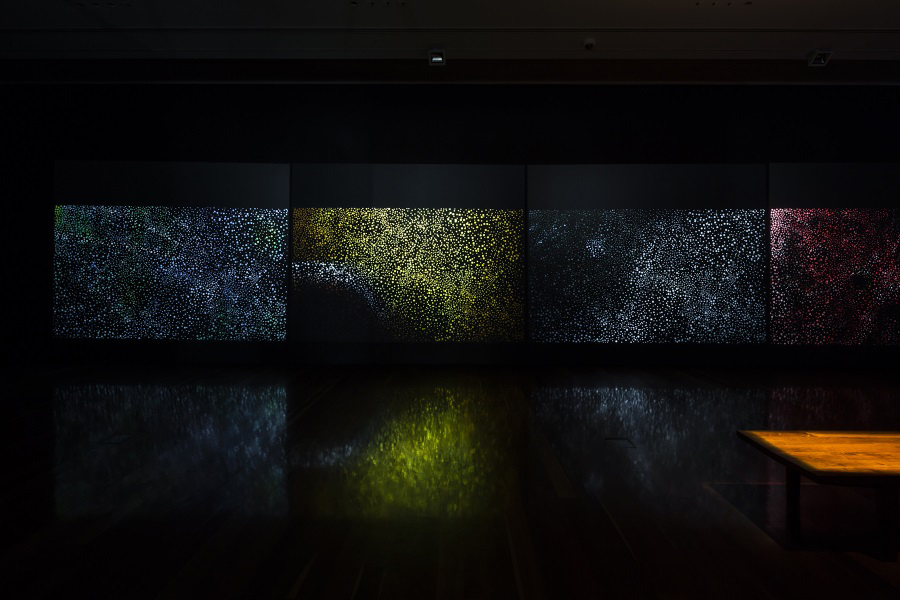2015 - Daniel Boyd: A Darker Shade of Dark #1– 4
Daniel Boyd: A Darker Shade of Dark #1– 4 / 9 October – 4 December 2015
Image: Daniel Boyd: A Darker Shade of Dark #1– 4, 2015, installation view, Samstag Museum of Art, University of South Australia. Photography by Sam Noonan.
A Darker Shade of Dark #1– 4 is a spectacularly immersive video installation and a compelling sensory experience not to be missed.
Daniel Boyd is best known as a painter whose theme of inheritance concerns the stories that are lost when overtaken by dominant colonial histories. His own rich family heritage provides a narrative source that he blends with moments from history. Further, he employs artistic links to Matisse, Picasso and the role of Primitivism in modernist aesthetics. The ubiquitous use of the iconic Papunya Tula ‘dot’ in his work is equally indebted to the techniques of Pointillism and Impressionism and becomes a distorting surface veil, or lens, through which his stories are only partially revealed.
Boyd’s dots also function as a metaphor for the corrosive effect of time and memory. In A Darker Shade of Dark #1– 4, his subject has shifted to the exploratory world of astrophysics; dark matter, particle physics and indeterminate cosmologies. Using shimmering and shifting fields of animated dots, his four-channel, floor-to-ceiling video projection is mysterious and dreamlike, magnetically drawing the viewer.
As today’s scientists embrace the challenge of understanding dark matter – the stuff that makes up most of our universe – so too Boyd calls us to the task of truly reconciling with the land’s Indigenous heritage, the largest part of our shared history.
Daniel Boyd: A Darker Shade of Dark #1– 4 is a Samstag Museum of Art exhibition in association with the Adelaide Film Festival and supported by the Festival of Contemporary Aboriginal and Torres Strait Islander Art, presented by the Art Gallery of South Australia.
Read the catalogue: Daniel Boyd: A Darker Shade of Dark #1– 4 by Ian Mclean.

Image: Daniel Boyd, A Darker Shade of Dark #1– 4, 2015, installation view, Samstag Museum of Art, University of South Australia. Photography by Sam Noonan.

Image: Daniel Boyd, A Darker Shade of Dark #1– 4, 2015, installation view, Samstag Museum of Art, University of South Australia. Photography by Sam Noonan.

Image: Daniel Boyd, A Darker Shade of Dark #1– 4, 2015, installation view, Samstag Museum of Art, University of South Australia. Photography by Sam Noonan.

Image: Daniel Boyd, A Darker Shade of Dark #1– 4, 2015, installation view, Samstag Museum of Art, University of South Australia. Photography by Sam Noonan.